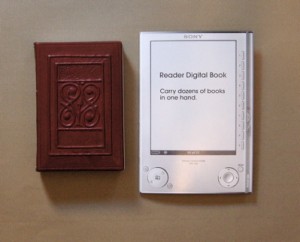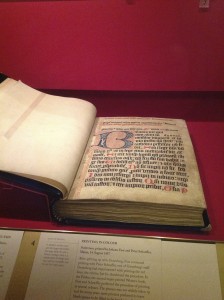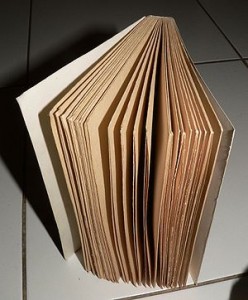Before I properly start blogging away, a short introduction to my undertaking is necessary. In the following months, I will be creating a number of blog posts encompassing what I hope will be a vast array of topics centering on the simple concept of printing. I will cover everything from trends in typography to conservation and preservation of books and media. As I go through the various topics, I will be creating comparisons between early book making and printing and modern forms of printing such as digital iPad books and blogs. This project is meant to be a broad look at the similarities and differences between the past and present of printed text.
The first topic I’m approaching is that of interactivity. In other words, how does one interact with books now in comparison to how people interacted with books some 800 (or more) years ago? This topic may be much broader than you think, as I plan to cover not only physical interaction with different types of books, but also the interaction between author and reader that has changed over the years.
To begin, we should figure out where books themselves started. Literature existed as soon as ancient Mesopotamians learned to write in the 30th century B.C. This ancient writing was engraved in stone or written on papyrus scrolls, some of which still exist. However, the “earliest surviving, intact European book” is from 700 A.D. This book, called the St. Cuthbert Gospel, is housed in the British Library and is in truly phenomenal condition thanks to massive conservation efforts. The Gospel is pocket size, bound in red goat leather and contains the Gospel of John. Early books such as the St. Cuthbert Gospel were written by hand and typically made for every day study or devotion. However, because books of this early age were so tedious to create, only well-educated, wealthy patrons owned books (or those with religious purposes). All of this seems fairly simple, but it’s surprising how quickly you might forget about the inaccessibility of books some 1300 years ago. In fact, until Johannes Gutenberg created the first printing press in 1439, allowing quick and easy printing, books were extremely rare.


Today, the accessibility of books has been taken to an extreme. Yes, the printing press made it easier to access printed material, but it wasn’t until digital books and e-readers were created in the 1990’s that access to books became so instantaneous. How then, have these e-readers changed the interactivity between people and their literature?
There are the obvious differences in technology we see when comparing the iPad or Kindle book to a simple paperback book. Those who own e-readers have thousands of books at their fingertips at any given time. You don’t have to walk to a library or head to the bookstore to read the latest and greatest, you can simply click a button and download anything directly. Does this instantaneous access to literature change the way we interact with print? Absolutely. Thanks to the Internet, many types of print literature (magazines, newspapers, books) have been thrown to the side as electronic versions pop up. Why bother buying a newspaper when you can log on to Yahoo! and see the day’s headlines? Printed text is slowly but surely becoming obsolete, as electronic versions become more popular because of their ease of use. It’s far less common to see some riding the bus with a paperback novel in their hand than it is to see someone scrolling away on their iPhone or Kindle on their morning ride.
When it comes to printed books, most are made up of signatures. Signatures are the individual sections of a book that can then be sewn together and into the binding of the book (by machine or by hand) to create a finished product. Signatures were originally created by folding large sheets of paper with various pages of text on them, and then stitching the insides to the binding of the book. This meant that the pages of the book were sealed (this is known as an uncut book or a deckle-edge book). If you’ve read the Great Gatsby, you might recall a conversation two characters had in Gatsby’s library about his books: “It’s a bona-fide piece of printed matter…What realism! Knew when to stop, too – didn’t cut the pages.” Gatsby’s library was full of “uncut” books, which tells you that this type of book was still around in the 20’s when Fitzgerald wrote Great Gatsby. Can you imagine having to cut the pages of your book when you finally received it? Even in the quite recent 1920’s, books were primarily for wealthy, well-educated people. Today, our ease of access to literature means we can interact so much more with our texts, no matter what our social standing.

A final point to make about today’s interactivity with literature is our modern-day ability to talk directly about a text as soon as we have read it. If you read a blog or article online you can immediately share your reaction with the rest of the public and view other peoples’ opinions on the literature as well. This is an extreme contrast to interaction with literature even just a few decades ago. People didn’t have the ability to tell a journalist how they felt directly upon reading an article. They had to send the journalist a letter or just discuss it with others around them who had read the story. This instant interaction between writer, reader and text is just another part of the new way we interact with literature and printed text.
From differences in accessibility to author-reader interaction, the interactivity of books has experienced major shifts in the last few decades. It’s hard to imagine a time when reading a book would require wealth, resources and time, but the days of limited access to literature are over, and increased access means a new way to appreciate literature of all kinds.
For further reading on ancient texts, visit the British Library at: http://www.bl.uk/
For further reading on book-binding, visit: http://www.kb.se/english/about/news/From-Grolier-binding-to-book-object/
– Claire Stasiewicz